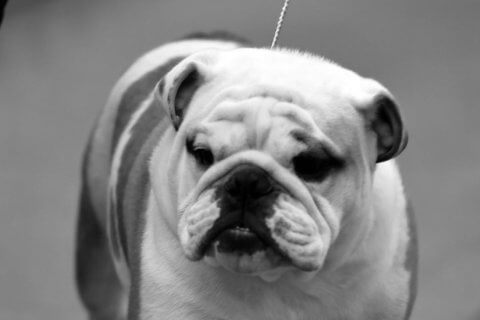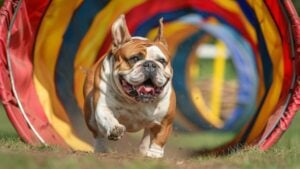
The Versatile Bulldog
Explore the Bulldog: a symbol of courage, history, and devotion. Learn about their traits, roles, and responsible breeding.
Home » Meet The Breeds » Bulldog
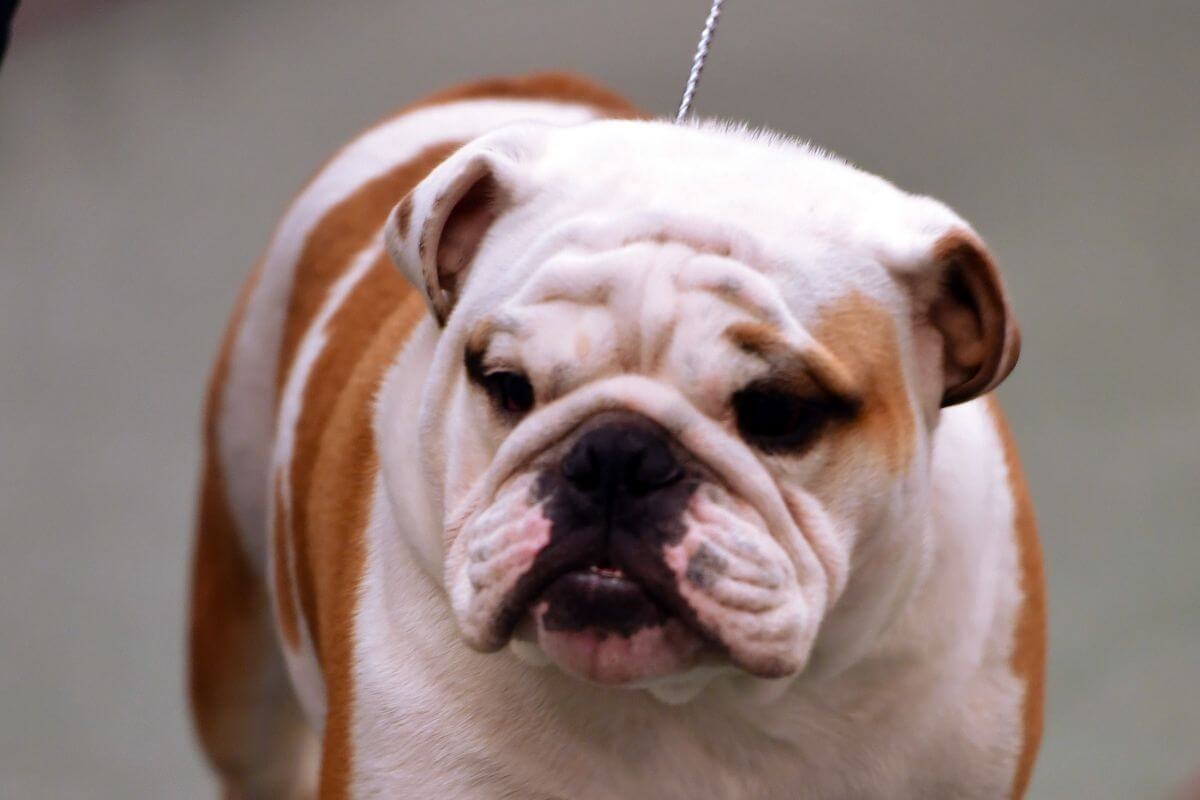
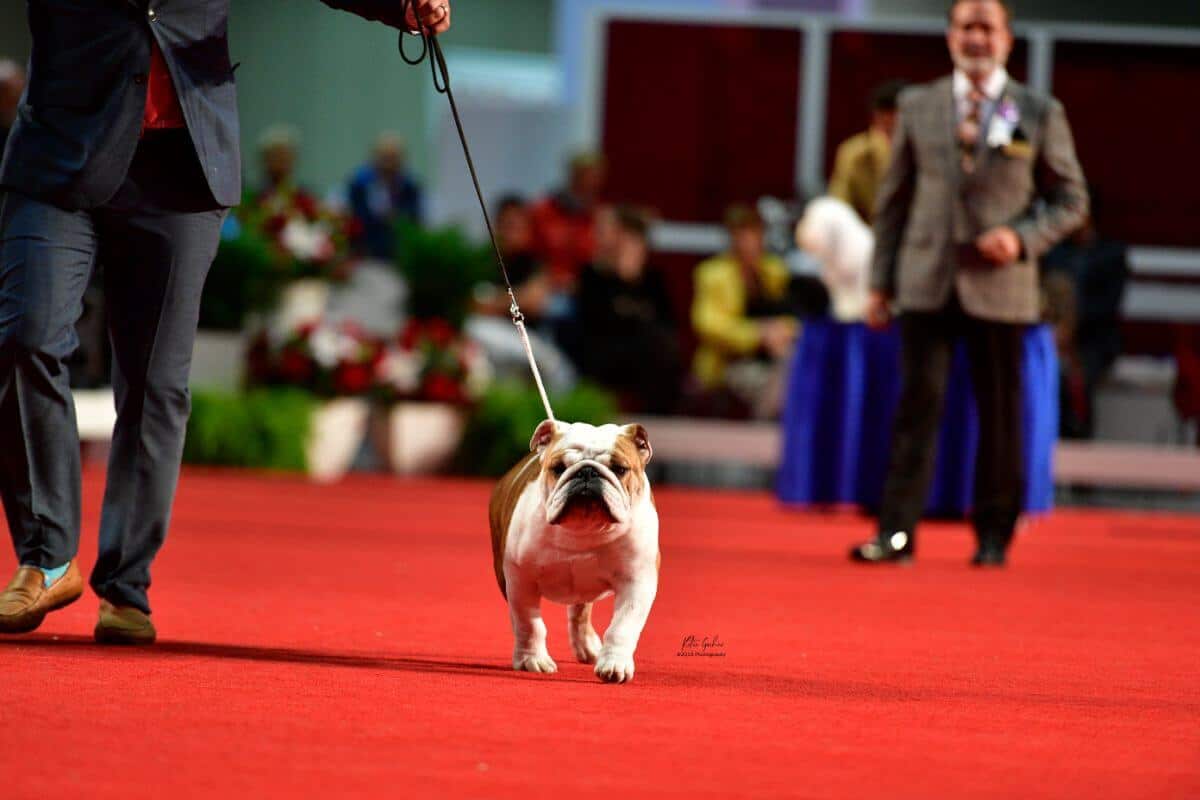
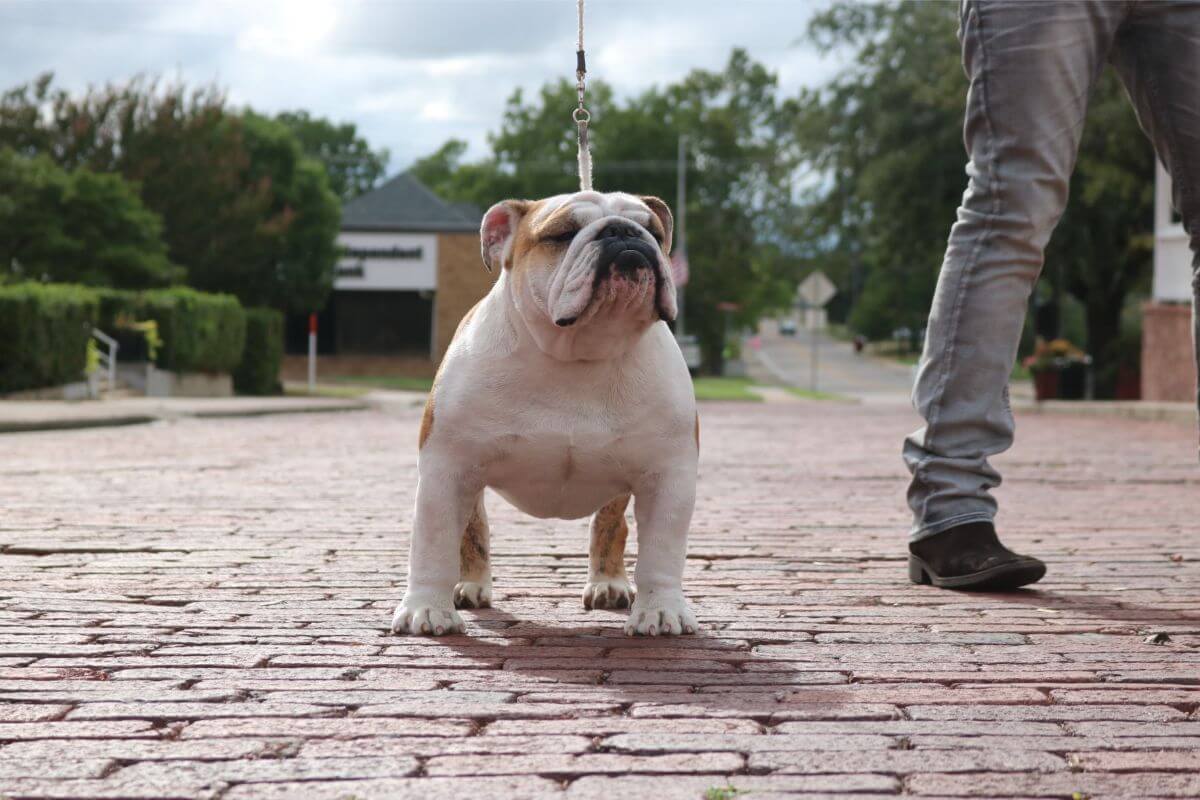
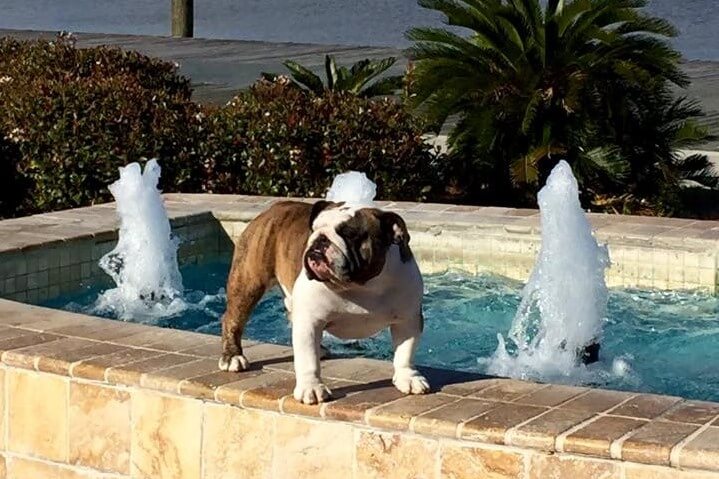
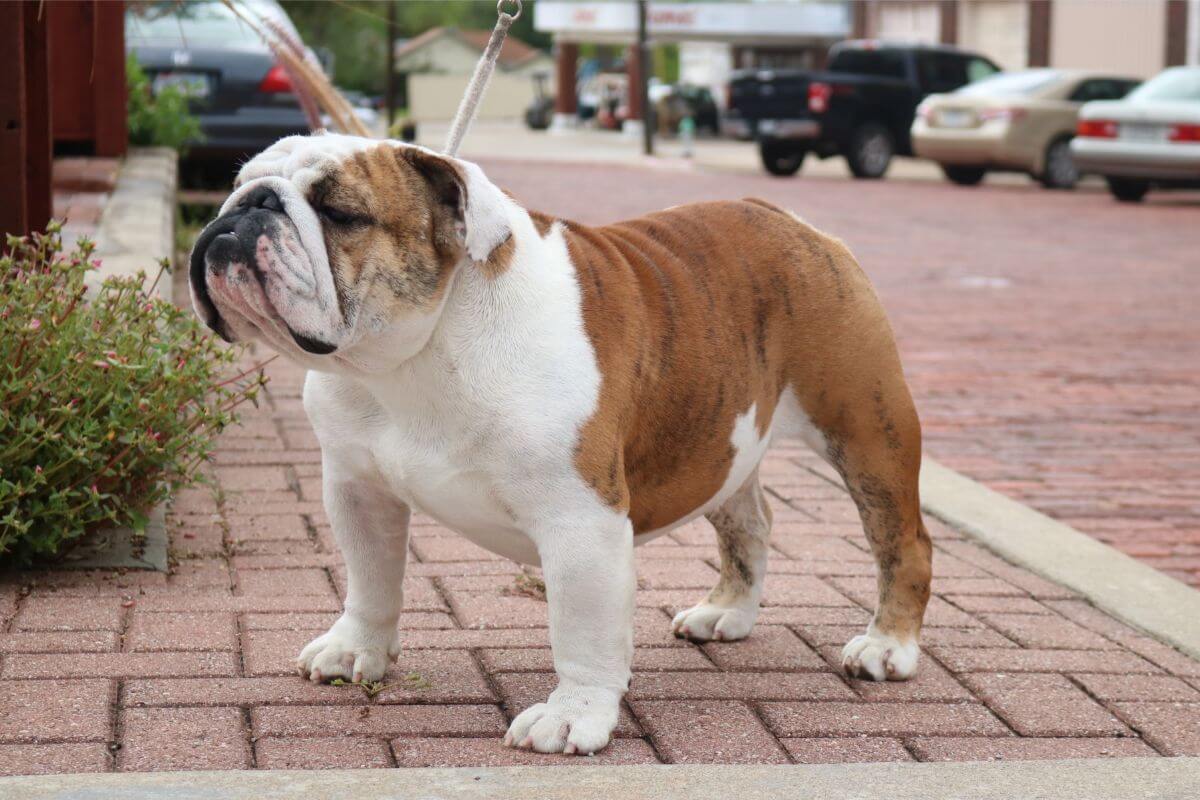
The Bulldog, sometimes referred to as the English or British Bulldog, is a popular purebred whose origins date back to the 13th century. Equable in nature and extraordinary in appearance, the breed has been developed from its bull-baiting roots to become a universally kind and courageous companion today. Its unique physical characteristics, such as a wrinkled face, undershot jaw, and rolling gait, suggest its historic purpose as well as its surprising agility, and its determined demeanor makes it a dog that simply cannot be ignored. The Bulldog develops a deep connection with each member of the household, making it a great choice as a courageous, and comical, companion.
Non-Sporting
14 – 15 inches
40 – 50 pounds
8 – 10 years
| Country of Origin | England |
|---|---|
| Bred For | Bull Baiting, Companionship |
| Known For | Affection, Courage, Wrinkled Face |
| Popularity | High |
| Temperament | Friendly, Courageous, Gregarious, Calm |
| Activities | Walking, Conformation Shows, Dog Sports |
The modern Bulldog is quite different from its ancestors, which were descended from ancient mastiff-type canines and developed entirely in England. The breed was first mentioned by name in 1500, illustrating a man with two Bulldogges, indicating the breed’s early existence. Back then, the dogs were actively involved in the violent sport of bull-baiting, where the dogs would aggressively grip the bull’s nose and vigorously shake it for sport.
Early Bulldogs were bigger and heavier than current breed, having been intentionally bred to excel at this rigorous pastime. They would crawl on their bellies to avoid the bull’s horns. Then, they’d use their powerful jaws to latch securely around the bull’s snout, refusing to let go. The dogs’ short, flat noses allowed them to breathe while maintaining their grasp, and their pain tolerance allowed them to withstand the grueling combat.
The road to recovery for the Bulldog was not without difficulties. The first Bulldog breed club was created in 1864, but it folded after only three years. The perseverance of Bulldog enthusiasts, however, triumphed, and in 1890, the Bulldog Club of America was created, setting a new standard for the breed. A Breed Standard was revised and adapted several times before finally becoming accepted in 1896.
The Bulldog’s popularity grew rapidly in the United States, eventually leading to the breed’s recognition by the American Kennel Club in 1890. Bulldogs have been popular as companion dogs ever since, achieving new heights in the 1940s and ’50s, and again in the 2010s and ’20s.
Mature Bulldogs typically stand between 12 and 16 inches tall at the shoulder, although adult females are generally shorter than the males.
Adult males typically weigh around 50 pounds, while mature females average around 40 pounds in weight.
The Bulldog is unforgettable, with a compact construction that differs from that of all other dog breeds. It has a deep and capacious body, well let-down between the shoulders and forelegs, giving a broad, low, and short-legged appearance overall. There is a fullness to the brisket and well-rounded ribs, and a comparatively narrow loin that contributes to the breed’s pear shape when seen from above. Despite the breed’s somewhat disparate parts and pieces, proportion and symmetry should never be compromised and no feature should be too prominent or obscure.
Texture: The single coat of the Bulldog is straight, short, flat, and fine in texture, with a smooth and glossy appearance. It is close-fitting on skin that is soft and loose, especially on the head, neck, and shoulders.
| Standard Color | |
|---|---|
| Fawn | ee |
| Fawn & White | ee |
| Fawn Brindle & White | ee |
| Red | ee |
| Red & White | ee |
| Red Brindle | ee |
| Red Brindle & White | ee |
| White | ee |
| Fawn & Brindle | ee |
| Fallow | ee |
A Note About Color: The Bulldog is a colorful breed, with a variety of colors and markings that make every individual a unique character. Whatever the dog’s coloration, colors are uniform, pure, and brilliant. Patterns and markings include brindle, piebald, ticking, black masks, and black tipping. All other colors and markings are unacceptable in the breed.
| Standard Marking | |
|---|---|
| Black Mask | ee |
| Piebald | ee |
| White Markings | ee |
| Ticked | ee |
| Black Tips | ee |
| Brindle | ee |
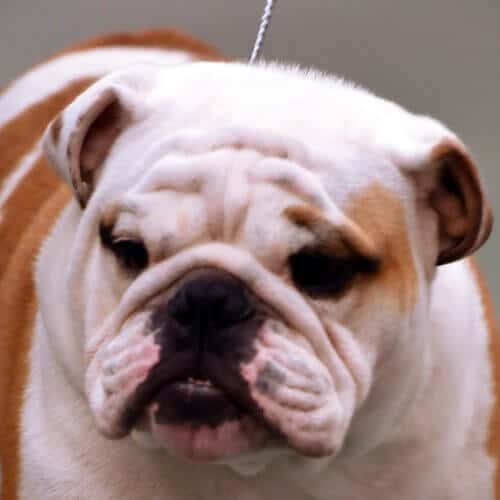
The Bulldog can have one of two different types of tail. Some have a tail that is straight, whereas others have a “screwed” tail. Straight tails are uniform in shape and taper towards the end. Screwed tails have well-defined bends and kinks, although these should never be elevated above the root of the tail. In either case, the tail is typically thick at the base, short, and hung low, with a decidedly downward carriage.
The Bulldog is typically gentle, affectionate, and good with families, making the breed an excellent choice as a companion in a variety of homes. These dogs are known for their loyalty and protective nature.; however, they can be a bit lazy and enjoy lounging around the house. They’re also known for their unique appearance, and their unusual faces can lead to respiratory issues. Bulldogs are social creatures that require regular interaction with their people. They can be prone to separation anxiety, so it’s important to ensure they’re not left alone for extended periods.
The Bulldog can be prone to certain health issues, including hip dysplasia, skin fold infections, eye problems, and respiratory difficulties due to the shape of the breed’s muzzle. Responsible breeding practices and regular veterinary check-ups are vital for maintaining the health of the breed and welfare of every Bulldog.
The average lifespan of the Bulldog is 8 to 10 years, but with good breeding practices, proper care, a balanced diet, and regular check-ups, many can thrive beyond these years.
The health of the Bulldog, like that of any dog, is a top priority for responsible breeders and owners. Due to the breed’s unique physical characteristics, individuals can be prone to certain health issues, including:
One of the most striking aspects of the Bulldog’s personality is its loyalty and devotion to its family. These dogs form a deep connection with their owners and their loyalty knows no bounds. Whether it’s a quiet evening at home or an adventurous family gathering, Bulldogs will enjoy it, offering everyone a heavy dose of love and companionship.
The Bulldog’s extraordinary appearance may extrude strength, but the breed’s true nature is remarkably gentle. These dogs are known for their enthusiasm and affection, and they can sense the emotions of their owners and provide comfort and solace when needed. Their gentle nature makes them excellent family companions, including families with young children.
The breed’s characteristic inner strength contributes to its usefulness as a family companion. Bulldogs have a natural instinct to watch over their loved ones, and this protective instinct, combined with their loyalty, reinforces the strong bond that’s shared between Bulldogs and their people.
Despite the Bulldog’s often laid-back demeanor, these dogs have a playful side. They enjoy games, toys, and playtime with their family members, and their lively nature can bring joy and laughter to the household. Bulldogs, it should be noted, typically make excellent playmates for children.
Another aspect of the Bulldog’s personality is its determination. This trait has strong historical roots, as the ancestors of today’s dogs were originally bred for bull-baiting and showed outstanding courage in the face of danger. While modern Bulldogs are not involved in such activities, their resilience remains. However, this can sometimes be translated as stubbornness which can make training an interesting, if occasionally frustrating, challenge.
Feeding and nutrition are foundational components of responsible Bulldog care. The Bulldog, with its unique appearance and characteristics, requires special dietary considerations to ensure its health and well-being. They are a brachycephalic breed, characterized by their snouts and facial structures. These physical traits affect their feeding habits and digestion so the diet should be formed according to that.
The Bulldog should do well on high-quality dog food, whether commercially manufactured or home-prepared under the supervision and consent of your veterinarian. Bulldogs need an adequate amount of protein to maintain muscle health. They are prone to obesity, so it’s crucial to monitor their fat intake.
Bulldogs may act like they’re always hungry, but owners should resist the temptation to overfeed. Portion sizes should be followed by labels on the dog food packaging considering the Bulldog’s age, weight, and activity level. Bulldogs can be prone to bloat or gastric torsion, a potentially life-threatening condition. To help prevent this, a slow feeder bowl can slow down their eating pace.
Obesity exacerbates respiratory difficulties in Bulldogs due to their brachycephalic structure. Maintaining a healthy weight can alleviate some of these issues. Keeping an eye on them to see whether they are gaining weight is important. Obesity can reduce a dog’s lifetime and put him at risk for additional health problems.
To train a Bulldog effectively, it is essential to understand the breed’s characteristics and temperament. Bulldogs are known for their loyalty, and they tend to be gentle, affectionate, and good-natured. However, they can also be strong-willed and possess a stubborn streak, so training can be challenging sometimes.
It is important to note that the typical Bulldog does not respond well to harsh training methods or punishment. Positive reinforcement works best and involves rewarding desirable behaviors with treats, praise, or affection, while ignoring poor behavior. Bulldogs respond well to this approach, as they are generally eager to please and want to do well.
Consistency and patience are paramount while training the Bulldog. The breed is not known as a quick learner, so it’s important to remain persistent and patient throughout the process. Consistency also extends to the use of positive commands and social cues.
Socialization is another crucial aspect of Bulldog training. Early and continued exposure to a variety of environments, people, and other animals can reduce the risk of fear or aggression in unfamiliar situations. It also helps the Bulldog puppy develop into a well-rounded and confident adult.
The Bulldog, with its stocky build and signature wrinkles, is often viewed as a couch potato. However, despite not being as hyperactive as some other breeds, the Bulldog does require regular periods of moderate exercise to maintain good overall health, prevent obesity, and ensure the dog leads a happy and fulfilling, if somewhat laid-back, life.
| Energy Level | Moderate |
|---|---|
| Exercise Requirements | 20 Minutes/Day (Minimum), Daily Walks, Regular Exercise, Playing with Another Dog, Mental Stimulation |
To keep a Bulldog at a healthy weight, regular exercise is necessary. A low-impact regimen will also aid digestion and support overall cardiovascular health. Since the breed typically walking, a daily stroll is an easy way to keep the Bulldog active and engaged. Depending on the dog’s age and fitness level, 20 to 30 minutes of walking per day should be enough.
Exercise is not only about physical fitness but also mental stimulation. Bulldogs benefit from activities that challenge their minds, preventing boredom and the destructive behaviors it encourages. Puzzle toys that dispense treats or require problem-solving can keep their minds active and engaged.
It’s important to consider a few safety precautions when exercising the Bulldog. The breed can be susceptible to overheating, so avoiding strenuous exercise during hot weather is crucial. These dogs can also be prone to joint issues, so excessive running or jumping, especially during their growth stages, should be avoided.
Regular exercise is a fundamental aspect of responsible Bulldog ownership. It not only maintains the dog’s physical health, it also keeps the mind active and strengthens the bond between dog and owner. Incorporating a variety of activities into a fitness routine, keeping safety in mind, will ensure that the Bulldog enjoys a healthy and fulfilling life.
Proper grooming is essential for the well-being, comfort, and overall health of the Bulldog. While the breed is relatively low-maintenance in comparison to some breeds, they do have specific grooming needs.
| Coat Type | Single, Straight, Short, Flat, Close, Fine, Smooth, Glossy |
|---|---|
| Grooming Requirements | Weekly Brushing, Occasional Bathing, Routine Ear Cleaning, Periodic Nail Trimming, Regular Tooth Brushing |
The Bulldog is not a heavy shedder, but regular brushing helps to keep any loose hair in check. Brushing should be done at least once a week to keep the coat healthy and reduce shedding. Since the breed has a short coat, a soft-bristle brush or grooming mitt will sufficiently do the job.
One of the most iconic features of the Bulldog is the breed’s wrinkled skin. These wrinkles require special attention to prevent irritation and skin infections. Gently cleaning and drying the folds using a soft cloth or baby wipe, ensuring the areas are completely dry, prevents any moisture-related skin issues from becoming a problem.
Bulldogs do not require frequent baths, since overbathing can strip the skin of its natural oils. Since some individuals can be prone to ear infections, the ears should be cleaned weekly to prevent infection. Excessive eye discharge and tear staining can also become a problem if these areas are not gently cleaned with a damp cloth and allowed to dry.
The Bulldog’s nails, if not naturally worn down through activity, will need periodic trimming. It’s essential to ensure the nails aren’t allowed to get too long, as overly long nails can lead to discomfort and even injury.
The Bulldog is an incredibly affectionate and loyal companion. These dogs form strong bonds with their owners and thrive on social interactions. Whether lounging on the couch, going for a walk, or just spending time together, Bulldogs are always by their owner’s side. The breed’s unwavering love and devotion make them wonderful additions to almost any household.
Bulldogs are famous for their amusing and quirky personalities. Their wrinkled faces, distinctive underbite, and expressive eyes often create comical and endearing expressions. With their charming antics, including their snoring, playful nature, and the way they tilt their heads when curious, they have a way of making anyone smile.
The Bulldog is not known for its high energy levels. This breed typically prefers a relaxed and low-energy lifestyle, making it a great companion for people who enjoy a more sedentary pace of life. While Bulldogs do enjoy playtime and short walks, they are content with long naps and quality time spent at home with their families.
The breed is not a heavy shedder and its short coat doesn’t require frequent brushing. However, special attention should be given to the Bulldog’s facial wrinkles and skin folds to prevent irritation and infection. In poorly bred dogs, the flat face can lead to breathing difficulties and overheating, especially in hot weather. Bulldogs may also be prone to certain health issues, including skin problems and joint concerns. Regular vet visits and a balanced diet are crucial for the well-being of every dog.
Bulldogs are prone to respond poorly to extreme temperatures. Due to their short muzzles, they are likely to overheat in hot weather and can also be sensitive to extreme cold. It’s essential, therefore, to always provide for the Bulldog’s comfort at home and outdoors, and to monitor its welfare when temperatures are extreme.
Bulldog puppies are undeniably adorable, but they do require special care and attention during their early stages of life. It is important to remember that each Bulldog puppy is unique, with individual personalities and needs that vary. It’s important, therefore, to tailor care and training to the pup’s specific requirements.
Health care is a critical aspect of Bulldog puppy care. Since this breed can be prone to specific health concerns, including brachycephalic obstructive airway syndrome (BOAS) and joint issues, regular veterinary check-ups are necessary to monitor the growing pup’s health and address any potential issues early on.
Socialization is key to raising a well-adjusted Bulldog puppy. Early exposure to various people, pets, and environments helps the youngster to become confident and sociable as an adult. It’s essential to introduce the puppy to different experiences gradually, making sure it is responding comfortably. This can help to prevent fear or aggression issues as it grows.
Feeding the young Bulldog is another crucial aspect of puppy care. A high-quality food, appropriate for the puppy’s age and size, is essential for ensuring proper growth and development. It’s also important to monitor weight gain, to be certain the pup is growing at a healthy rate, and to avoid overfeeding, as Bulldogs can be prone to obesity.
Training the Bulldog puppy requires patience and consistency. This breed can be a bit stubborn, so positive reinforcement methods work best. Basic training should begin early to establish good behavioral habits and create a strong bond between the puppy and its caretaker. Crate training can also be beneficial for housebreaking and for providing a safe space for the puppy to call its own.
While Bulldogs are not typically known for their athleticism, they can still participate in various dog sports that are adapted to their physical capabilities and temperament. Engaging in these activities can help to keep this breed mentally and physically stimulated while strengthening the bond between each owner and their furry friend.
The Bulldog is recognized by the world’s leading registries and kennel organizations, which categorize the breed into a specific Group based on its unique characteristics. This breed is recognized worldwide under the following Group designations:
| Organization | Group Designation |
|---|---|
| AKC (American Kennel Club) | Non-Sporting |
| UKC (United Kennel Club) | Companion Dog |
| CKC (Canadian Kennel Club) | Non-Sporting |
| ANKC (Australian National Kennel Council) | Non Sporting |
| RKC (The Royal Kennel Club) | Utility |
| FCI (Fédération Cynologique Internationale) | Group 2: Pinscher and Schnauzer Molossoid Breeds – Swiss Mountain and Cattle Dogs; Section 2.1: Molossoid breeds, Mastiff Type |
The ideal Bulldog is described by a Breed Standard that is approved by each of the world’s leading registries and kennel organizations. The Breed Standards for this breed may be found in the following links:
| Organization | Breed Standard |
|---|---|
| American Kennel Club | AKC Bulldog Breed Standard |
| United Kennel Club | UKC Bulldog Breed Standard |
| Canadian Kennel Club | CKC Bulldog Breed Standard |
| Australian National Kennel Council | ANKC Bulldog Breed Standard |
| The Royal Kennel Club | RKC Bulldog Breed Standard |
| Fédération Cynologique Internationale | FCI Bulldog Breed Standard |
Bulldog clubs are organizations dedicated to the promotion, preservation, and welfare of the Bulldog as a unique breed. These clubs often serve as valuable resources for breed enthusiasts, providing information, support, and opportunities to engage with fellow Bulldog owners and breeders.
The Bulldog Club of America (BCA) is the oldest and one of the most recognized Bulldog clubs in the United States. Founded in 1890, the BCA is dedicated to preserving and promoting the well-being of all Bulldogs. The club’s members provide educational resources and information on breed standards, and organize various social and competitive events, including the National Specialty show.
The Bulldog Club of Canada (BCC) is an club dedicated to the promotion, preservation, and welfare of Bulldogs in Canada. It serves as a resource for Bulldog enthusiasts and owners across the country, providing information, support, and opportunities for engagement with supporters of the breed.
Bulldog rescue groups are organizations dedicated to rescuing and rehoming dogs in need. The groups’ volunteers work tirelessly to provide a second chance for Bulldogs that may have been abandoned, surrendered, or even found as strays. They also focus on educating the public about the breed and advocating for responsible dog ownership.
Bulldog Club of America Rescue Network (BCARN) is affiliated with the Bulldog Club of America and operates a network of Bulldog rescue groups across the United States.
Bulldog Club of Canada has a rescue program that provides rescuing and rehoming of Bulldogs all over Canada. The volunteers’ efforts not only provide relief to dogs in distress, they also offer potential adopters an avenue to join a community of people who share a love for the breed.
Bulldogs typically have a lifespan of about 8 to 10 years. Some may live longer with excellent care, provided they’re given a proper diet, regular exercise, and timely veterinary checkups. Their lifespan is typically somewhat shorter compared to other breeds of similar size.
Bulldogs are not inherently aggressive. They were originally bred for bull-baiting, but today’s Bulldogs are bred to be gentle and affectionate. However, like any dog, individual temperament can vary, so proper socialization and training are essential.
Bulldogs were originally bred in England for bull-baiting , a dangerous sport that involved the dog grabbing onto a bull’s nose and roughly shaking it. This practice was outlawed in the 19th century, after which Bulldogs were bred to be companion animals, leading to a significant change in temperament.
Bulldogs are not natural swimmers. Due to their brachycephalic (short-nosed) facial structure and stocky body shape, they often struggle to stay afloat and can tire easily in water. It’s important to supervise Bulldogs closely around water and consider using a dog life vest.
Yes, Bulldogs shed. Their short, fine coat sheds year-round, and they may experience a slight increase in shedding during seasonal changes. Regular grooming can help to minimize the amount of loose hair that’s left on furniture and clothing.
Bulldogs are a medium-sized breed, with males typically weighing around 50 pounds and females about 40 pounds. They stand from 14 to 15 inches tall at the shoulder, with a low-slung, stocky build.
Bulldogs are not generally considered dangerous. In fact, they are widely known for their friendly and docile temperament. However, as with any breed, individual dogs can exhibit aggressive behavior at times depending on the circumstances, so training and socialization are key.
Bulldogs are not hypoallergenic. They shed and produce dander, which are common allergens for people with dog allergies. The breed’s short coat requires regular brushing to help manage the shedding.
Bulldogs are intelligent, but they can also be stubborn. They are known for their ability to problem-solve, but they can require more patience and consistency during training sessions due to the breed’s independent nature. Bulldogs will typically excel in activities that match their pace and personality.
Bulldogs do have tails, although they are typically short and either straight or “screwed.” The tail’s length and shape can vary from dog to dog, and this is a natural variation within the breed. It is not docked or altered.
Bulldog males typically weigh around 50 pounds, while females usually weigh about 40 pounds. It is important to closely monitor a Bulldog’s weight, as some dogs may be prone to obesity, which can exacerbate a few health issues common to the breed.
Bulldogs are not inherently lazy, but they do have a more laid-back and relaxed demeanor compared to more active breeds. They enjoy short walks and play sessions, but also love lounging around the house and are content with moderate levels of activity. Overexertion, especially in hot weather, should always be avoided due to the breed’s unique conformation.

Explore the Bulldog: a symbol of courage, history, and devotion. Learn about their traits, roles, and responsible breeding.
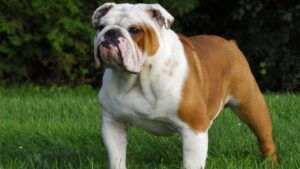
Explore the Bulldog’s storied history, from bullbaiting roots to its modern evolution as a beloved and resilient breed.
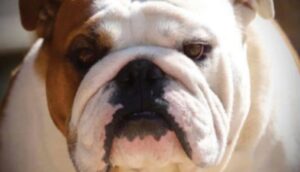
Understanding the Bulldog as a ‘Head Breed’—balanced breed traits and the significance of the head in breed standards.
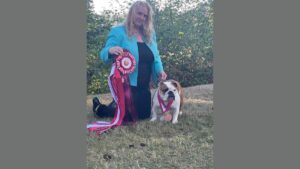
Discover Anna Dolegiewicz’s journey in Bulldog breeding, honoring her late husband Bish, with a focus on health, quality.

Explore Jay Shen’s Bluemount Bulldogs & French Bulldogs, focusing on breed standards, health testing, and ethical breeding practices.

Link Newcomb is the breeder behind Newcomb/Coastbull Bulldogs.Read about the kennel’s beginnings, puppies, and much more!
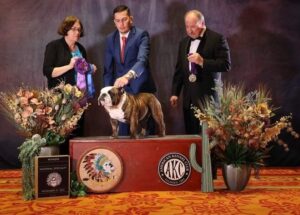
Purebred Bulldogs Breeder Anne Hier – Ampirion Bulldogs Interview by Allan Reznik. I was born in Flint, Michigan, and grew up in the country
The best way to ensure a long and happy relationship with a purebred dog is to purchase one from a responsible breeder. Not sure where to begin?
Contact the National Parent Club’s Breeder Referral Program, which is listed on the AKC Breeder Referral Contacts page.
